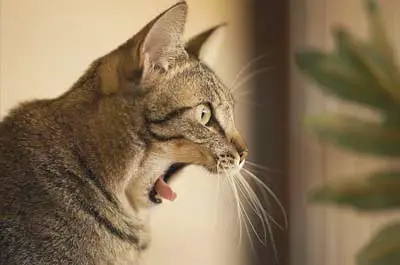We all know that cats are pretty smart animals. But just how smart are they? This complete guide to cats and their behaviors will answer all your questions about these fantastic creatures. From their intelligence to their quirks, you’ll learn everything you need to know about cats in this comprehensive guide. So if you’re a cat lover or want to learn more about these fascinating animals, read on! You won’t be disappointed.
Cats are undoubtedly one of the smartest animals around.
Anyone who owns a cat knows they can be intelligent creatures. They are experts at manipulating their humans, often getting precisely what they want through a combination of cuteness and persistence. They are quick to learn tricks, adept at opening doors and cabinets, and capable of understanding complex commands. For example, if a cat wants to get into a room that is closed off, it will figure out how to open the door. They are also experts at getting into small spaces. This demonstrates an impressive level of cognitive ability, which is one reason cats are such excellent hunters.
But cats are not just smarter than other domesticated animals like dogs and rabbits- they also have a level of intelligence that rivals that of primates. Studies have shown that cats can solve complex puzzles, use tools, and even recognize their own names. Cats also have an excellent memory and can remember faces, locations, and patterns. So the next time your cat gives you that cute little meow, remember that they might be trying to tell you something.
How do cats see the world?
Cats have excellent night vision and can see in six times less light than humans, and they can also see in ultraviolet light. This allows them to see things we cannot, such as camouflaged prey in the dark.
They also have a wider field of view than humans—about 200 degrees, compared to our 180-degree field of view. Cats’ eyes also contain more rods, which are responsible for black-and-white vision, than human eyes. This helps them see better in low light but produces poorer color vision. Instead of seeing the world in red, green, and blue as we do, cats primarily see blues and yellows with some greens. This limited color palette likely explains why cat food is often brightly colored: it looks more appealing to them than it does to us!
Cats also have a third eyelid, or nictitating membrane, which helps to protect their eyes from debris and keeps them lubricated. This membrane is usually only visible when a cat is tired or sick. Finally, cats’ pupils can open much wider than ours, allowing them to absorb more light. Combined with their reflective layers of tissue called the tapetum lucidum, which helps to amplify available light, these super-pupils give cats the ability to see in very dim conditions.
How does a cat’s brain work?
A cat’s brain is quite different from that of a human or another animal. Compared to humans, cats have significantly more neurons in the cortex, which is responsible for complex thought and behavior. This may explain why cats are so intelligent, curious, and inventive!
In addition to their impressive cognitive abilities, cats also have a unique structure in their brains called the amygdala. This part of the brain is responsible for emotions and helps cats feel fear, anxiety, and pleasure. Interestingly, this structure is also linked with a cat’s sense of time; studies have shown that cats can remember events from several months ago and use this memory as a reference point when making decisions in the present. Cats are one of the most fascinating animals on the planet, with complex brains and an impressive level of intelligence. And thanks to their ability to manipulate humans, they can often get what they want!
How do cats communicate with each other?
How cats communicate with each other has been a topic of debate among animal behaviorists for many years. Do they use body language? Do they vocalize? How do they understand each other? The answer, it turns out, is all of the above. Cats are brilliant animals, and they have a complex system of communication that allows them to interact with each other in various ways.
When two cats meet for the first time, they will often touch noses to exchange scent information. This scent exchange helps them to determine if the other cat is a friend or foe. If the scent exchange is positive, the cats will usually start to groom each other as a sign of affection. If the scent exchange is negative, the cats may hiss or spit at each other as a sign of aggression. In addition to scent and body language, cats also communicate through vocalizations.
They meow to greet each other, yowl to show affection, and growl to express aggression. By understanding how cats communicate with each other, we can better understand their behavior and provide them with the best possible care.
Can cats be smarter than people?

There’s no easy answer to this question, as intelligence is hard to define and measure. However, some experts believe cats are smarter than humans in specific ways. For instance, cats have a much better sense of smell than we do- which comes in handy for hunting prey or avoiding danger.
They also have superior night vision and can hear sounds we can’t even register. Additionally, cats have more efficient brains than we do, meaning they use less energy and take up less space. So while they may not be able to read or write, it’s clear that cats have some serious cognitive advantages over humans.
How do cats show affection?
Cats are often seen as aloof and independent, but they can be very affectionate creatures. Cats show their love in various ways, from purring and blurring to simply spending time with their human companions. While each cat expresses affection differently, there are some common behaviors that all cats display when feeling affectionate. Purring is perhaps the most well-known sign of a cat’s affection. Cats will often purr when they’re being petted or held, and it’s thought that this behavior helps them bond with their humans.
Cats also show their love by following their humans around, rubbing against them, and giving them headbutts. This behavior is known as “allorubbing,” and it’s thought to be a way for cats to mark their humans as part of their social group. So next time your cat rubs against you or gives you a headbutt, take it as a sign of their love!
What motivates cats?
While we may never know exactly what goes on inside a cat’s head, some key factors seem to motivate kitty behavior. For instance, cats are attracted to movement, so a ball of string or a feather toy can be a powerful motivator. They also respond well to food, so a plate of tuna or a tasty treat can be very motivating. In addition, cats seem to enjoy the challenge of trying to figure out new toys or puzzles, so these can also be good motivators.
Ultimately, each cat is different, and what motivates one may not work for another. However, by understanding what makes cats tick, we can provide them with the stimulation they need to lead happy and healthy lives.
The different types of cat personalities.

There are many different types of cat personalities, each with its unique set of behaviors. Here is a brief guide to the most common types of cat personalities:
- The Independent type is self-sufficient and does not require much attention from its owner. This type of cat is often content to spend its time alone, sleeping, or exploring its territory.
- The Playful type is energetic and loves to play games. This type of cat enjoys chasing toys and climbing trees.
- The Sociable type enjoys spending time with humans and other cats. This type of cat may purr when being petted and follow its owner around the house.
- The timid type is shy and easily frightened. This type of cat may hide when strangers come into the house and are uncomfortable with loud noises.
Although all types of personalities have their distinct traits, every cat is unique and special in its own way.
How can you tell if your cat is happy or not?
Cats are notoriously difficult to read and don’t show their emotions as openly as dogs or humans. However, a few key behaviors can indicate whether or not your cat is content. Their body language is full of information, and by paying attention to the cues they send, we can get a good idea of how they’re feeling.
For instance, cats who are purring or kneading are usually happy and relaxed. If your cat is rubbing against you or another object, they’re likely trying to mark its territory. And if your cat is yawning, licking its lips, or blinking slowly, they’re probably happy and comfortable in its current surroundings. A happy cat usually has soft, relaxed features with its mouth slightly open. If they look tense or stressed, it indicates something isn’t right. Of course, every cat is different, and the best way to gauge your feline friend’s emotional state is to spend time with them and get to know their unique behaviors.
But if your cat is depressed or unhappy, it may be reluctant to play or engage with you. They may also hide away and avoid human contact or become aggressive or defensive if provoked. If your cat is showing any of these signs, it’s vital to seek professional help from a veterinarian to address the underlying causes.
How do cats learn new things?
Cats learn primarily through observation and trial and error. When they see another cat doing something, they often imitate it. This is how kittens learn many basic survival skills, such as hunting and grooming. If a particular behavior results in a positive outcome, the cat will likely remember it and repeat it in the future.
Cats also have a strong memory, which helps them remember things that they have learned in the past. This is why it is essential to socialize kittens early so they can learn to trust and interact with people. Once a cat has learned something, it will usually remember it for life. The key to teaching a cat is to use positive reinforcement, such as treats or praise, to encourage desired behaviors. This way, cats can learn to adapt to their environment and thrive in any situation.
Conclusion.
Whether they enjoy playing games, exploring new territories, or spending time with their human companions, cats are intelligent and fascinating creatures worth getting to know.
So, how smart are cats? The answer is that it depends on the cat! Each feline has its unique personality and ways of learning and interacting with the world. By understanding what motivates cats and how they learn new things, we can provide them with the care and attention they need to live happy, healthy lives. Leave a comment below and let us know what you think!

Meet Brenda Tillman: your go-to expert in Cognitive Behavioral Therapy! Not only is she a seasoned therapist, but she’s also a passionate mom blogger who never misses a beat. Dive deep into her insightful blogs, backed by her extensive coursework in Parenting Skills, Learning, and Education. Brenda’s heartwarming family – a son, two daughters, and their adorable pets – often take center stage in her writings. From parenting hacks and relationship tips to health & fitness nuggets, Brenda has been enlightening her readers for over half a decade. Stick around, and you’re bound to discover gems from a mom who wears many hats with grace!
Reviewed By: Joanna Perez and Marcella Raskin
Edited By: Lenny Terra
Fact Checked By: Gabrielle J. Smith
Photos Taken or Curated By: Matthew Mansour